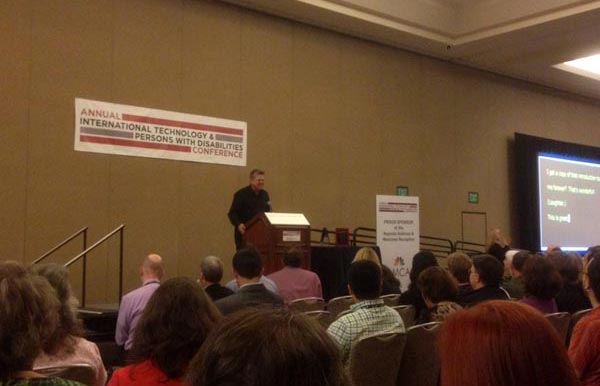Another CSUN conference has come and gone, and they only get better each year. Of course I’m referring to the CSUN (California State University, Northridge) Annual International Technology and Persons with Disabilities Conference which happens at the incredible Manchester Grand Hyatt Hotel in downtown San Diego, California.
The conference was officially kicked off Tuesday evening with a keynote speech by Tommy Edison (starts at 9:45) who is also well known as the @BlindFilmCritic.

Events & Happenings
Besides the plethora of sessions to attend, many events (official and unofficial) and fun things were going on:
- There was a lot of talk (and behind the scenes) about the International Association of Accessibility Professionals (IAAP).
- Two hack-a-tons occurred which was great! A TPG Bug Bash and an ARIA Hackathon by organized by @JohnFoliot.
- I attended the Project Possibility’s SS12 Finals where the “Code for a Cause” contest is concluded. The contest is among university teams for the best accessible application. The winner was the CSUN team for a camera app for the blind.
- Deque Systems announed a $10,000 Amaze Grant to Fix The Web initiative
- Stevie Wonder was in da house! Check out this news feature, Stevie Wonder Touts Technology for Impaired (NBC San Diego). And check out Billy Gregory’s selfie with the music legend!
- I personally enjoyed handing out Easy Chirp 2 stickers 😉
Highlighted Sessions
There are too many great sessions to note, but here’s are several to get you started:
- Accessibility myths for a mobile generation (SlideShare) by @jonhassell
- Introduction to Accessibility Testing (Slideshare) by @PatrickDunphy
- Practical ways to make your website accessible by @jfc3
- Developing a Web Accessible Modal Dialog (PPT) by @DennisL (Web Axe author)
- Where Usability Meets Accessibility (Slideshare) by @whitneyq
Summary Next Year’s 30th
Next year is the 30th CSUN and promises to be even bigger and better than ever. Seriously, there are tremendous plans for CSUN15 are already under way. Hope to see you there!
More Resources
- The Great Big List! on Curb Cut blog (by @mactoph)
- Conference Twitter hashtag: #CSUN14
- CSUN 2014 wrap-up by Robert Pearson (on Access iQ blog)
